I would rate red mites as being one of the biggest problems you will face when keeping chickens. Red Mites live in the cracks of chicken houses (typically under perch ends) coming out at night, crawling onto your birds for a feed.
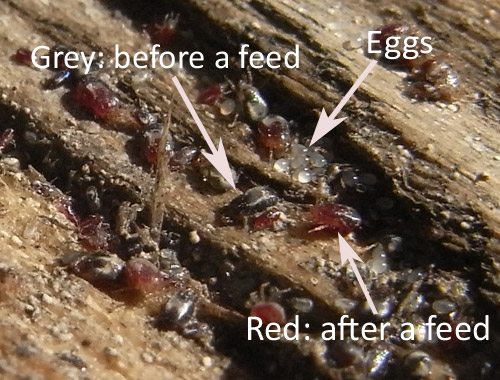
Macro shot of Red Mite in a crack on a perch. These were disturbed after a treatment with Poultry Shield.
They start off as very small greyish-white mites that swell up into red coloured mites after a feed and at their biggest are only 1mm so small numbers of them can be hard to spot unless you know what to look for.
You will often find a grey ash like deposit around perch ends which is where the mites have been and if you lift the perch, you will see clumps of mites.
Red Mite in chickens’ houses are active during the warmer months, usually May to October and will become dormant over the winter. They multiply at an incredible rate: their life cycle is just 7-10 days. In other words from hatching from an egg to being an adult laying hundreds of eggs takes just a week if conditions are right.
Be Proactive.
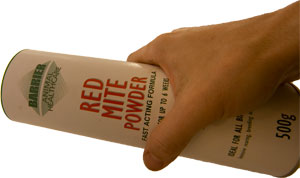 The best course of action is to check for red mite routinely when you clean your chicken house out and use some preventative treatment to the house before they get a hold. You will get to know the places to look and once you have found small numbers of them, you can treat the house to keep numbers under control. See my ‘preventative measures’ below
The best course of action is to check for red mite routinely when you clean your chicken house out and use some preventative treatment to the house before they get a hold. You will get to know the places to look and once you have found small numbers of them, you can treat the house to keep numbers under control. See my ‘preventative measures’ below
Are there Red Mite in your Chicken House?
People normally discover Red Mite when they are over-run by them. When hens are being bitten, they can refuse to go in to roost at night, they will become anaemic and their combs will go pale. They will often stop laying and you may find red blood stains on eggs (squashed Red Mites). Eventually, you will start to see losses in the flock.
Checking for Red Mite in Chickens Houses
Red Mite will hide away in the daytime but can often be seen if you lift perches, examining the ends. They will usually come swarming out if you treat the cracks with Poultry Shield but by far the easiest way to check to see if there are red mite is to take a piece of white kitchen roll and to rub it along the underside of the perch when your hens are roosting (in the dark). Look at the tissue and if there are Red Mite heading back from their feed, they will be squashed on the kitchen roll as streaks of blood.
Getting rid of Red Mite
It is very hard to get rid of them completely so it is often better to get the numbers down and then find a way of keeping them down that doesn’t involve you spending hours on cleaning the house out. There are lots of different treatments that people use, some more effective than others but I will focus on what I do and have found to be the most successful for me.
If you haven’t got red mite and the weather is warm enough for them (May to October in the UK) then skip step 1 and go straight to step 2. Preventative Measures.
1. Getting rid of an infestation.
If you find lots of red mite in the coop, it’s time for a big clean up that will take a couple of hours initially, then an hour every 5 to 7 days for at least 2 more weeks.
The products I have found to work the best (that are relatively safe) are Poultry Shield and Diatom. These two are not ‘knock down’ products as such, they do take a little while to work but are none the less very effective. I also use Red Mite Powder on the hens themselves to help them through the night when the Mites are active.
You can BUY Poultry Shield from Amazon Here.
Here is what I do with the Poultry Shield.
- Remove all birds from the house.
- Strip the house down as much as possible.
- Clean the house out – be careful where the bedding is going as red mite live for 6 months without a feed and will find a new home If they can. Ideally seal the bedding in bin bags or burn.
- Mix up as many watering cans of poultry shield mixture as is needed, as per the instructions on the label 1 part to 9 parts water.
- ‘Water’ all cracks in the chicken house, concentrating where there are perch ends and concentrations of red mite.
- Leave to soak for 15 minutes
- Red mites will be coming out. Cover them and the cracks with poultry shield again.
- Wait 15 minutes
- Hose out the house, concentrating on getting the pressure jet into the cracks and so on.
- Leave the house to dry.
Poultry Shield is a mild detergent and ‘washes’ the waxy coat off the red mites. It is also good for removing organic matter from the hen house so is useful for cleaning. I wouldn’t be without this!
After using the Poultry Shield, when the house is dry, I use Diatom. Diatom is made of micro skeletons of fossilised remains of diatoms. These were once a kind of algae found in water. They are microscopically sharp and pierce the outer waxy coating of the mites which causes them to dry out and die.
The second step also double up as my ‘preventative’ measures if you haven’t yet got a bad infestation
You can BUY Diatom from Amazon HERE
2. Preventative Measures
- Dust the ends of the perches / nest boxes and where ever else you found concentrations of red mites when cleaning.
- Rub as much into the perches as you can. Red mite will avoid the diatom and will crawl around it if they can, so make sure they have to crawl through it to get a feed.
- Repeat every couple of days for as long as you see signs of red mite in the coop.
Repeat the whole cleaning process if there are still lots of mites in 5 to 7 days. You will find you might not need to spend as long on the washing as there won’t be as many mites.
Very Important: Make sure you repeat it before 7 days so that the mites don’t have a chance to lay more eggs. A few mites become a lot in a very short space of time!
If you have a felt roof on your chicken house and they get underneath, it is usually impossible to get rid of them without removing the felt, cleaning and re-felting. My page on Chicken Houses gives more information.
Finally, I will dust the hens down between their feathers with Red Mite Powder to give them some respite during the night when the mites are active.
Beware of what you read!
There is a lot of information written about these troublesome ectoparasites on the internet these days, much of it re-written and re-spun. When I started writing about them, there was little available online. Strangely, some small errors that I had introduced on my page that I corrected in an update pop up frequently on other websites. Running a Google image search often uncovers companies that have used my copyrighted images! I make regular checks to try to stop this from happening.
If you wish to learn more about red mite then I would encourage you to read the guide to red mite on poultrykeeper.com. This is a reliable source of information and is regularly updated.

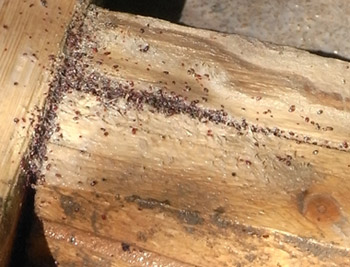

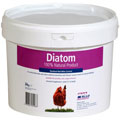

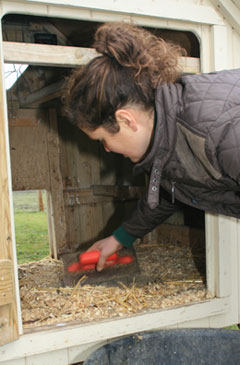
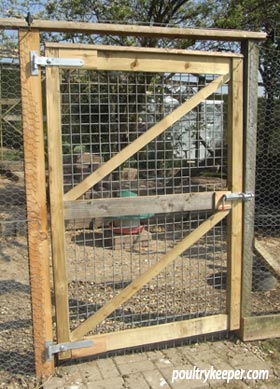
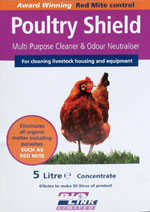
Hello I have been reading all the red mite trouble people are having. I have just got my red mite problem under control. I burnt the wooden coop that was totally infested. I think you have to look at the design of the coop you have and the state of repair it is in. If it is very difficult to clean with poultry shield or just has so many crevices in it then you should ditch it. You will need to burn itand I would say buy a plastic omlet coop. I bought a second hand one because they are pricy but it is so easy to clean and also to see what is lurking on and in it! I did buy proper creosote not the substitute stuff and I treated the largest coop I have that appeared not to have a red mite in it. We took it apart as much as we could. We did not remove the glued on roof felt which you will need to do and burn it if your coop is infested or you will not get rid of them. I bought creosote from the Internet it is in a 25L container which we didn’t want such a quantity but that is how it comes You will need to wear protective clothing and a respirator mask very important and avoid contaminating the ground around your coop, cover the area put the coop on plastic or something. Just be sensible ! Don’t over soak the wood with it as it takes along time to dry but make sure you get into every crevice just don’t leave excess creosote on the wood. Then each year we will need to treat the coop. Because you do need to let the coop dry out you need another coop for your chickens to go in. It takes a good three weeks! I had the same problem as another person, the red mite were crawling on me even though I has not near the coop like they were on the grass. I would say if you have an infestation wear different clothing and foot wear ( wellie boots you can wash down) tuck your trousers into them where rubber gloves and if you are working on the coops wear a plastic shower cap or something to stop them getting in your hair. It has to be like some military operation ! Strip off outside the house and shower. These red mite things are not nice they have a 7 day cycle so you need to be cleaning your coop down every 3 days and dusting your chicken also vaseline the chicken legs. This makes it more difficult for the horrible things to crawl up there legs. You just have to be systematic about it and try not to despair ! Don’t leave your poor chickens in a totally infested coop it will be like hell on earth for them with those blood sucking things and remember these red mite things can infest your house, if you look on the blogs people have had this problem. I also gave my hens the red stop adaptive in there water for ten days changing the water each day. And the hen that was in the infested coop I ended up giving topical ivermectin drops on to the skin at the back of the shoulder blades and then having an egg withdrawal period. Good luck Claire
Good to hear you’ve got on top of them Claire. I have just recently treated my (wooden) coop. I used a cheap 5 litre pressurised garden sprayer and put poultry shield in it. I went all over the cracks and once dry, hosed the coop out with a spray gun.
Before the coop was completely dry, I dusted diatom around throwing lots around the walls where it stuck.
I checked yesterday and I also seem to be on top of them – with this warm weather we’re having, thy multiply quickly!
Hi we appear to have red mite in our chicken coop, it is wooden and a good few years old, if we replaced it and treated the hens would we then be fairly free of mite, or do they live on the ground as well as in the coop?
Also I forgot to ask, where they have been on me, are they likely
to be able to live in our house or on our dog?
There have been reports of mites infesting homes, although it is rare. People also say they bite them and their animals although I’ve never ever had them do this – they crawl on me and make me itch but I always shower after treating a coop and put my clothes in the washing machine and that’s the end of them.
I’ve never found them on the ground. Mites that get washed off the coop don’t ever appear to crawl back up the legs – I think they dry out in the sun. They like dark cracks and crevices to hide in.
Hello,
We’ve been treating our chicken house for red mite and a few jumped on our dog and therefore some got into the house on her. Are they likely to spread in the house and what measures can we take? Have looked online and can see that they sometimes infest houses but I’m not at all clear whether a fee in the house is enough to start infestation.
Thanks
My guess is they won’t be a problem – yes, there are many reported cases of problems, however my experience with my local friendly red mite population is that they crawl on you and make you itch but don’t infest other animals.
I’m sure there are some strains that are a problem but I believe some of the reported cases you read about are red mite being confused with other problems. Fleas are a big problem this year apparently (so a number of vets have told me in conversation) which could easily be confused with red mite if you were to see a dog scratching and getting bitten.
I would give your dog a bath using a shampoo and I don’t think the red mite will survive.
Thank you, this is very reassuring. We did bath the dog but also treated her with something from the vet to be on the safe side. We don’t seem to have had any further indoor visitors (think the few we did see came in on my husband’s clothes), and I’ve been doing a lot of hoovering and have ordered some tea tree oil as a further deterrent. Fingers crossed! The chicken house has been jet washed and repeatedly sprayed and we seem to be winning the battle there too, although early days yet from what I’ve read online. It’s been a bit alarming and I’ve found this forum very helpful, thank you.
Hi,
I have redmite in my coop at the moment, my hens don’t seem to be too bad but I am going to clean the coop tomorrow with poultry sheild then dust with powder. I have also read that WD40 is Ok to use to kill the mites and mite eggs. Is this true and is it safe?
WD40 isn’t tested on chickens and isn’t approved for such use.
There is a lot of information on the internet that suggests many unsafe treatments. The worst one I came across was to use old engine oil on chickens feet!
You have to be careful what you do with chickens because not only could you be harming them but you can also be putting chemicals into the eggs you eat.